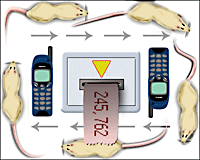Categorisation of Queues and a Guide to Queuing
Created | Updated Apr 19, 2011

Queuing is a time-honoured English tradition, a well-practised art and a guaranteed stumbling block for the uninitiated. This entry is a brief guide to some of the many different types of queues that exist, and the unwritten rules that surround them.
The Common or Simple Queue
This type of queue is the most basic of all queues and consists of two or more people standing behind or beside each other in a line. This is the best place to start for those wishing to learn the rules of queuing, and the visitor to England will find many such lines to join where they can practise this ancient and fulfilling pastime.
There are, however, many more complex queues that may be encountered during an average day in England. Outlined below are some of the more tricky queues that might be experienced.
The Maze Queue
This type is most commonly seen in larger banks and post offices and looks similar to the type of queuing system used for rides in theme parks.
In previous decades, queues at post offices would require a separate line for each counter. This invariably meant the queue you were in would always move the slowest and a great way to pass the time was to skip from one line to the next in the vain hope of being served more quickly. However, modern times demand that everyone has equal right to be in a really slow queue and so the modern maze queuing system was created. Queuers stand in single file around zigzags of rope fencing and the person at the front of the queue goes to the next available cashier.
There are many benefits to this type of queue: a large mass of people can be crowded into one place while remaining in an orderly queue, when previously the same queue would have stretched out of the door and half way down the high street. The rope fencing provides bored children with something to swing on, in the manner of chimpanzees at the local zoo, and it is also much easier to have a really good nose1 at all the other queuers in the room.
The Electronic Queue
This truly is a queue for a modern electronic age. It is the type of queue that is common at the cheese counter in supermarkets and involves queuers taking a numbered ticket and then waiting for the number to be displayed on an electronic screen. This does, however, suffer from annoying people (children mostly) taking a load of tickets so the system ends up slowly going through ten or 20 non-existent customers before getting to the next real one.
The Queuer-initiated System
This queue is an amalgamation of the first two queue types and occurs when no formal queuing system is in place. Places in which this type of queue may be found include smaller banks, post offices that do not have an organised Maze Queue, and railway stations. This type of queue is formed automatically and without prompting by queuers and may cause some trouble for those unaware of its rules. One long, single line is instinctively formed by the queuers, and the person at the front proceeds to the next available cashier.
The Concealed Queue
At first glance, this queue does not look like a queue at all. It is a queue for the more experienced and confident queuer and should be avoided by the beginner unless accompanied by a skilled practitioner. This type of queue occurs in any situation when there are two or more people waiting for something, but no visible formal queuing system in place and no room to form a line.
To the casual observer the situation may look like a group of people standing around or sitting in waiting-room chairs, but these queuers are experts and are led by an instinct or sixth sense. Each member of the waiting group intuitively knows who is next in the queue, and one by one each takes his or her turn.
The Telephone Queue
This form of queue is the product of the modern age and, unlike the previous queuing types mentioned, is not a place in which the English like to be stuck. This queue has an almost metaphysical quality as queuers are unaware of each other's presence or their place in the queue. While being held in this type of queue, a form of aural torture known as Muzak is usually played, which is regularly interrupted by polite messages reminding the person on hold that their call is in a queue, and will be dealt with as soon as someone is available.
Queue Rage
One of the side-effects of novice queuers barging into an established queue at the wrong point or, heaven forbid, jumping the queue, is queue rage. This is characterised by loud tutting and meaningful glares, sometimes accompanied by ostentatious arm-folding and foot-tapping. The symptoms may worsen if the miscreant remains unaware of their actions, or, worse still, appears blatantly unrepentant.
In the most acute cases, a sufferer of queue rage may experience feelings of high-level irritation for several hours after the event. This is a little recognised syndrome, and is prevalent mainly in the UK.
Last Word
And finally, always remember that there are many types of queues and many situations when they may occur. It is possible that even the most experienced practitioner may occasionally breach queuing etiquette, but do not let this put you off trying this pastime for yourself. If an accidental faux pas does occur, just spend the rest of your time in the queue apologising profusely and blushing humbly - not only will this resolve any problems, but also show everyone else in the queue that you truly are a sporting queuer.

